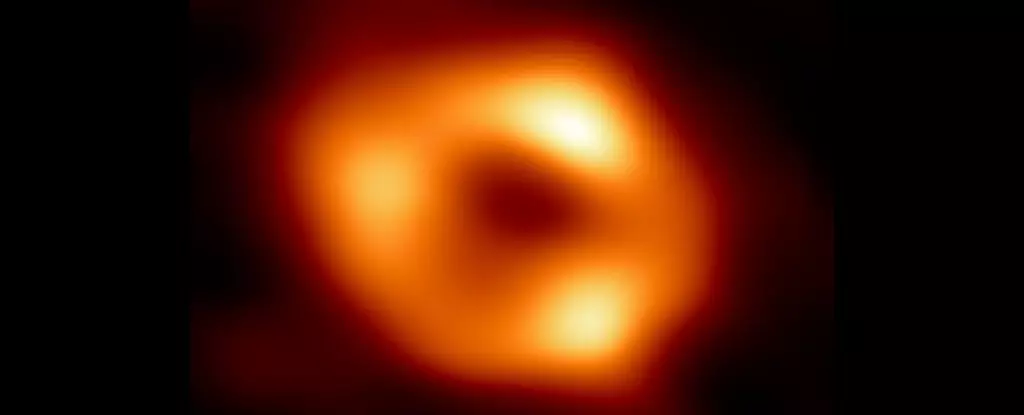The cosmic wonder of Sagittarius A*, the supermassive black hole at the center of our Milky Way galaxy, recently made headlines with the release of what was believed to be its definitive image. However, emerging research from the National Astronomical Observatory of Japan (NAOJ) has raised questions about the accuracy of this visual representation. New analyses suggest that the structure surrounding Sgr A* may be significantly different from the circular shape initially presented by the Event Horizon Telescope (EHT) in 2022. This article endeavors to explore these groundbreaking findings and their implications for our understanding of black holes.
When the EHT team unveiled the first image of Sgr A*, it marked a pivotal moment in astrophysics. Eight ground-based radio telescopes collaborated to form an interferometry network that captured the enigmatic silhouette of the black hole’s accretion disk. The resulting image featured a bright ring encircling a dark core, providing a tantalizing glimpse into the characteristics of this cosmic behemoth. Yet, the analysis method employed by the EHT could not fully account for the complexities involved in interferometric imaging, which often results in challenges related to data completeness and interpretation.
The observed circularity of Sgr A* seemed to suggest a relatively uniform distribution of matter around the black hole. Nevertheless, researchers like Miyoshi Mikato from the NAOJ have posited that the portrayal may, in fact, be an illusion—a product of artifacts from the data processing stage.
In a bid to provide a more nuanced interpretation of the data, the NAOJ team re-examined EHT’s original images using alternative analytical techniques. Their findings suggest that the structure of the accretion disk may be more elongated in shape, specifically in the east-west direction. The modifications to the image reveal a notable brightness disparity, with the eastern section of the disk appearing significantly brighter than its western counterpart. This asymmetry could indicate the dynamic processes at play within the accretion disk, including variable material distribution and velocity effects, leading to a rotation speed estimated at about 60% of the speed of light.
The implications of these findings extend beyond mere aesthetics; they actively challenge our interpretations of accretion mechanisms and the fundamental processes underlying black hole formation and behavior. Armed with this information, scientists are better positioned to explore the physical conditions that influence the configurations of material around supermassive black holes.
The Dancing Material: Insights into the Accretion Disk
At the heart of this discussion lies the accretion disk itself—a swirling mass of superheated gas and dust that spirals into Sgr A*. This disk is thought to radiate energy across a wide spectrum, including X-rays and visible light, as material succumbs to the immense gravitational pull of the black hole. The heating of this material is primarily due to friction and magnetic activity, illuminating the intricate relationship between gravity and thermodynamics within extreme environments.
The intricate dance of matter around black holes is influenced by several factors, such as angular momentum, spin rates, and the overall accretion rate. The gravitational forces exerted by the black hole introduce significant distortion, akin to viewing a reflection in a warped mirror, which complicates the task of capturing an accurate image. Given such hurdles, it is not surprising that different methods of analysis can yield divergent representations of the same astrophysical object.
No imaging system can produce a flawless astronomical representation, as emphasized by Miyoshi and corroborated by the shortcomings observed in EHT’s approach. The inherent gaps in the interferometric data necessitated the use of various computational strategies, leading to the rounded image initially produced by EHT. Conversely, NAOJ’s re-evaluation adopted a different mapping methodology that skillfully smoothed over some of these data gaps, resulting in the elongated representation of the accretion disk.
The success of this method underscores the importance of methodological rigor in astronomical research. Adapting approaches to tackle the complexities of the data can yield richer insights and expand our understanding of black holes and their environments, as evidenced by the newly identified Doppler effects that contribute to the brightness disparities observed in the re-analyzed image.
The discoveries stemming from the NAOJ’s re-analysis pave the way for a deeper understanding of the accretion dynamics surrounding Sgr A*. Enhanced imaging capabilities, coupled with comprehensive studies of the material surrounding black holes, promise to illuminate the mysteries of these intricate cosmic structures. The collective pursuit of this knowledge will undoubtedly refine our understanding of the universe’s most enigmatic entities, and the ongoing work of the EHT consortium aims to break new ground in black hole astrophysics. As we continue to unravel the complexities of Sgr A*, each revelation will contribute to a larger narrative of cosmic evolution and the fundamental principles that govern our universe.


Leave a Reply